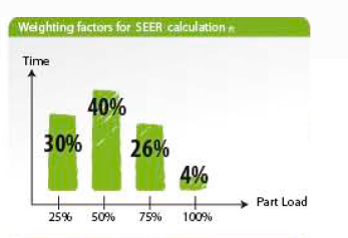Rated and seasonal efficiency

Refrigeration and air conditioning units have historically been classified in terms of energy consumption based on rated (nominal) efficiency (EER, Energy Efficiency, Ratio), i.e. the ratio between cooling capacity delivered and power consumption in the worst-case operating conditions, typically calculated for operation in summer at full load.
In less demanding conditions, the unit needs to operate at part load, which means, in other words, in different working conditions than rated.
This certainly different values of EER.
Taking as example a simple unit with a fixed speed compressor, which has represented the most widespread type of unit worldwide for years; this reduces cooling capacity by switching the compressor on and off periodically.
Whenever it restarts it works for several minutes at low efficiency until reaching steady operation, and as it may need to restart as many as 6-10 times an hour, the consequence in terms of energy consumption is evident.
The EER values of this kind of unit are lower at part load conditions when compared to full load.
It’s also easy to understand how operation at full load involves just a small fraction (around 1 to 10%) of typical total operating time.
As a result, the classification based on rated EER gives little insight into actual efficiency.
In recent times, the drive to save energy around the world has led to more suitable methods being devised that categorise units based on the seasonal energy efficiency ratio (SEER), i.e. weighted to account for actual climatic conditions and typical load.
In these terms, traditional refrigeration units have a low seasonal energy efficiency ratio. This is leading to revolutions in design and the adoption of increasingly advanced technology.
The technologies that most significantly increase the seasonal energy efficiency ratio are undoubtedly electronic controllers, motor-driven expansion valves (also called electronic expansion valves) and capacity modulation systems for compressors, fans and pumps, with inverters clearly being the most efficient of these.
Related products and applications
| c.pCO sistema |  |
| pCO sistema |  |
| DC inverter |  |
| Chiller/Heat Pump units |  |
| CRAC |  |
| Heat Recovery Unit |  |
| Rooftop |  |
| Dryers |  |
| Temperature control units |  |
| HEOS Sistema |  |
| HECU Sistema |  |
| HECU CO2 |  |
Do you need more informations? KNOWLEDGE CENTER
KNOWLEDGE CENTER
